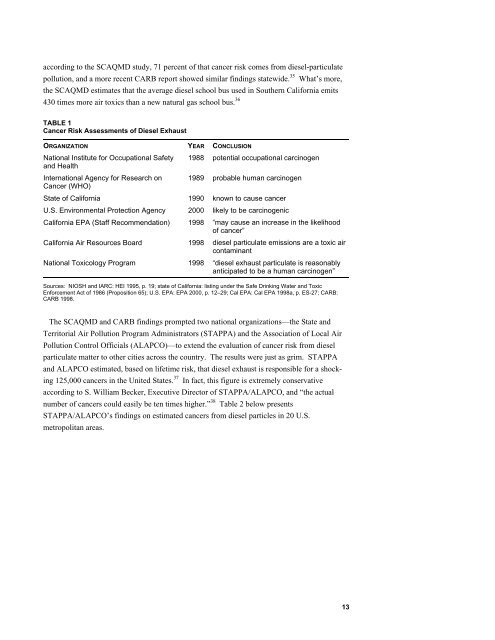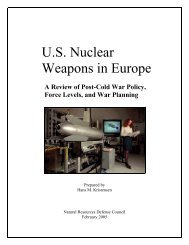NRDC: No Breathing in the Aisles: Diesel Exhaust Inside School ...
NRDC: No Breathing in the Aisles: Diesel Exhaust Inside School ...
NRDC: No Breathing in the Aisles: Diesel Exhaust Inside School ...
You also want an ePaper? Increase the reach of your titles
YUMPU automatically turns print PDFs into web optimized ePapers that Google loves.
accord<strong>in</strong>g to <strong>the</strong> SCAQMD study, 71 percent of that cancer risk comes from diesel-particulate<br />
pollution, and a more recent CARB report showed similar f<strong>in</strong>d<strong>in</strong>gs statewide. 35 What’s more,<br />
<strong>the</strong> SCAQMD estimates that <strong>the</strong> average diesel school bus used <strong>in</strong> Sou<strong>the</strong>rn California emits<br />
430 times more air toxics than a new natural gas school bus. 36<br />
TABLE 1<br />
Cancer Risk Assessments of <strong>Diesel</strong> <strong>Exhaust</strong><br />
ORGANIZATION YEAR CONCLUSION<br />
National Institute for Occupational Safety<br />
and Health<br />
1988 potential occupational carc<strong>in</strong>ogen<br />
International Agency for Research on<br />
Cancer (WHO)<br />
1989 probable human carc<strong>in</strong>ogen<br />
State of California 1990 known to cause cancer<br />
U.S. Environmental Protection Agency 2000 likely to be carc<strong>in</strong>ogenic<br />
California EPA (Staff Recommendation) 1998 “may cause an <strong>in</strong>crease <strong>in</strong> <strong>the</strong> likelihood<br />
of cancer”<br />
California Air Resources Board 1998 diesel particulate emissions are a toxic air<br />
contam<strong>in</strong>ant<br />
National Toxicology Program 1998 “diesel exhaust particulate is reasonably<br />
anticipated to be a human carc<strong>in</strong>ogen”<br />
Sources: NIOSH and IARC: HEI 1995, p. 19; state of California: list<strong>in</strong>g under <strong>the</strong> Safe Dr<strong>in</strong>k<strong>in</strong>g Water and Toxic<br />
Enforcement Act of 1986 (Proposition 65); U.S. EPA: EPA 2000, p. 12–29; Cal EPA: Cal EPA 1998a, p. ES-27; CARB:<br />
CARB 1998.<br />
The SCAQMD and CARB f<strong>in</strong>d<strong>in</strong>gs prompted two national organizations—<strong>the</strong> State and<br />
Territorial Air Pollution Program Adm<strong>in</strong>istrators (STAPPA) and <strong>the</strong> Association of Local Air<br />
Pollution Control Officials (ALAPCO)—to extend <strong>the</strong> evaluation of cancer risk from diesel<br />
particulate matter to o<strong>the</strong>r cities across <strong>the</strong> country. The results were just as grim. STAPPA<br />
and ALAPCO estimated, based on lifetime risk, that diesel exhaust is responsible for a shock<strong>in</strong>g<br />
125,000 cancers <strong>in</strong> <strong>the</strong> United States. 37 In fact, this figure is extremely conservative<br />
accord<strong>in</strong>g to S. William Becker, Executive Director of STAPPA/ALAPCO, and “<strong>the</strong> actual<br />
number of cancers could easily be ten times higher.” 38 Table 2 below presents<br />
STAPPA/ALAPCO’s f<strong>in</strong>d<strong>in</strong>gs on estimated cancers from diesel particles <strong>in</strong> 20 U.S.<br />
metropolitan areas.<br />
13
















